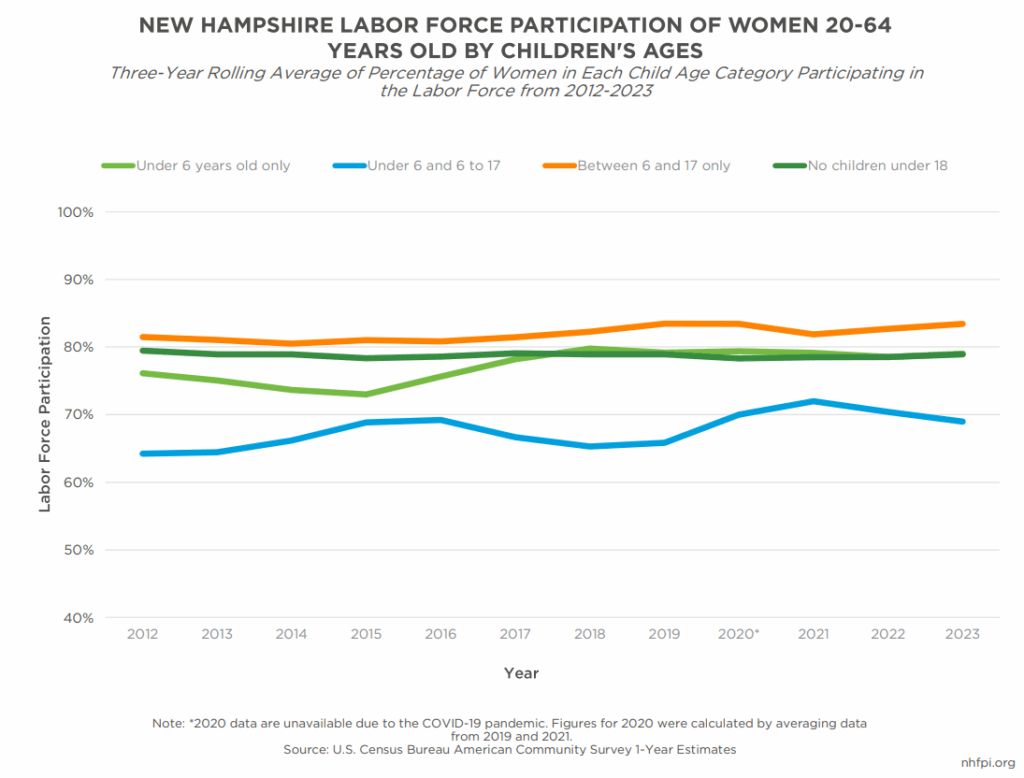This Mother’s Day, the NHFPI team is honoring the hard work of New Hampshire moms by doing what we do best: highlighting key data that shows the challenges – and contributions – of mothers across the Granite State.
Moms in the New Hampshire Labor Force
Based on data collected from 2019 to 2023, there were approximately 126,667 Granite State mothers between the ages of 20 to 64 with children under 18 years old who lived with them. Among this group, about 80.0 percent were in the labor force.
Moms aged 20 to 64 with at least one child under 18 years old made up about 13 percent of the 2023 Granite State labor force. Here’s how that 13 percent breaks down:
- 3%: Mothers with at least one child under age 6
- 2%: Mothers with at least one child under 6 and at least one child between 6–17
- 8%: Mothers with at least one child between 6–17
Labor force participation rates among Granite State mothers have varied over time since 2012, especially when broken down by the age of the children women have. Work force participation rates among mothers with children between the ages of six and 17 have remained consistently higher than all other groups, including women without any children under 18.
Participation rates increased for women with at least one child under six around 2015 and have remained relatively consistent with rates of women without any children under 18 since that time. For those mothers with at least one child under six and at least one child between six and 17, labor force participation rates dipped between approximately 2016 and 2019 but increased around 2020. Participation among this group had a small decline after 2021 through 2023. Future examination among this group will determine if these patterns continue.
Fertility Rates
New Hampshire mothers gave birth to 11,761 babies in 2024, based on provisional estimates from the U.S. Centers for Disease Control. Like many states, New Hampshire is experiencing reduced birth rates; however, the trends may be more acute in the Granite State. New Hampshire had the 5th lowest fertility rate of all U.S. States and the District of Columbia in 2023, with 46.8 births per 1,000 Granite State females ages 15-44.
Of all pregnancies in 2020 in New Hampshire, almost one third (30.1 percent, 3,448) were unintended; these respondents reported that they either wanted the pregnancy later, never, or were not sure.
Maternity Leave Access
While maternity leave allows women to remain in the labor force after giving birth and also bond with their newborn, access to paid leave may be limited for Granite State mothers. According to the most recent, publicly available data from New Hampshire Department of Health and Human Services (DHHS), 42.1 percent (2,789) of mothers took only paid maternity leave in 2020, 25.6 percent (1,041) took both paid and unpaid leave, and 38.7 percent (2,566) took only unpaid leave.
Maternal Mental Health
Pre-and postpartum depression and anxiety is, unfortunately, common among New Hampshire Granite Staters giving birth.
According to the most recently available data from New Hampshire DHHS from 2020:
• 23.1% of New Hampshire moms experienced depression or anxiety before pregnancy
• 19.0% of New Hampshire moms reported depression during pregnancy
• 17.5% of New Hampshire moms sought help for postpartum depression
• 14.8% of New Hampshire moms received a postpartum depression diagnosis
• 12.2% of New Hampshire moms experienced postpartum depression symptoms
Stay informed about issues that impact New Hampshire families and communities—subscribe to our weekly newsletter, The Bottom Line, at nhfpi.org/subscribe.

